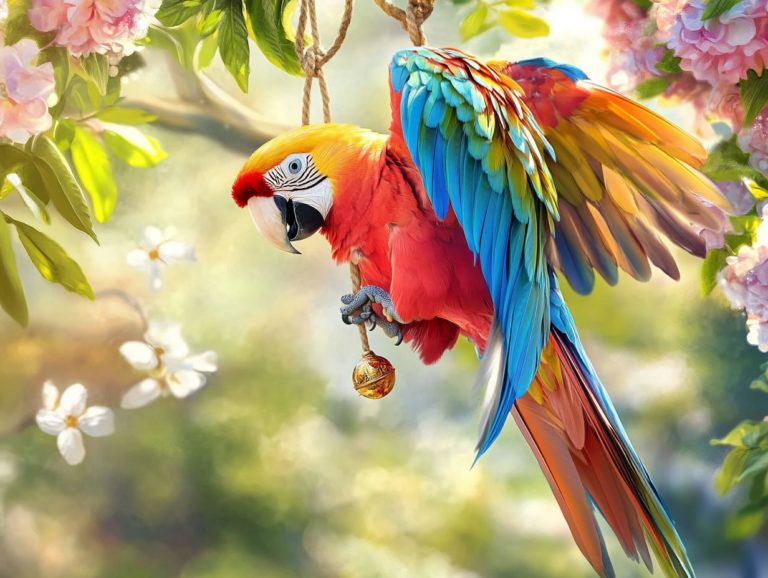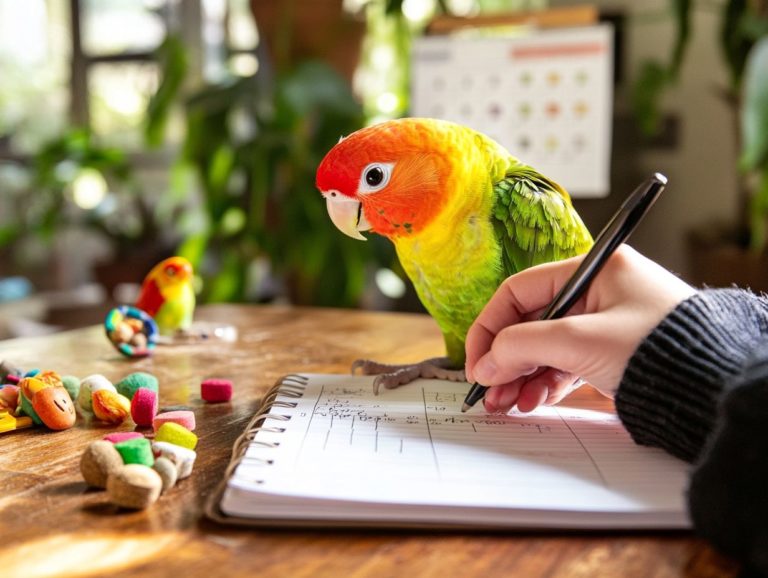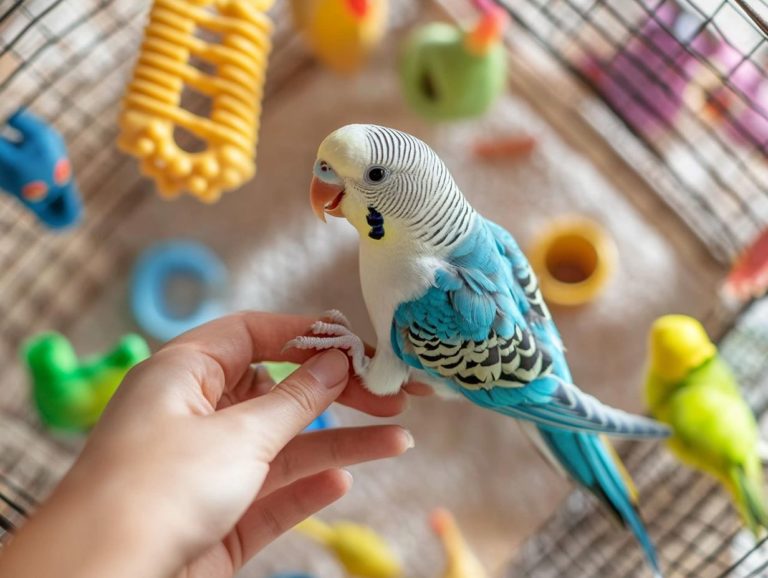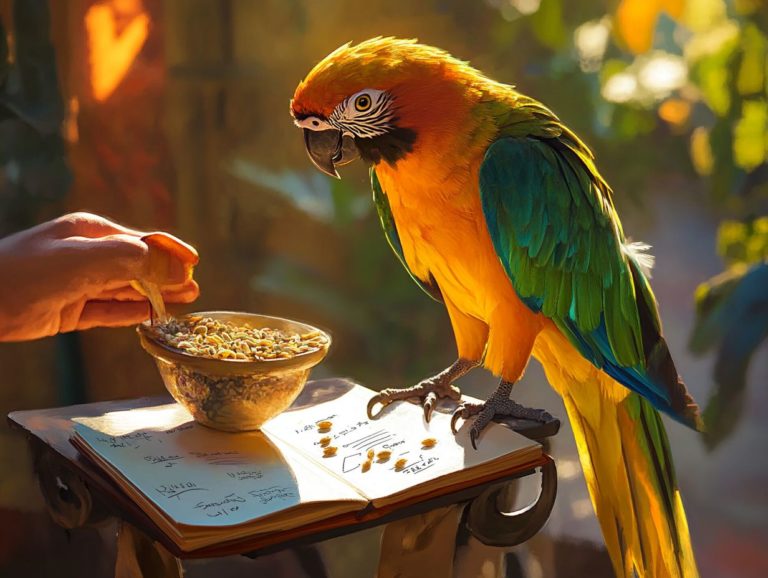Socialization Tips for Newly Adopted Birds
Bringing a new bird into your home is an exhilarating journey, brimming with opportunities for connection and companionship. This guide will equip you with the essential steps to ensure your feathered friend feels safe and at ease in their new environment.
You ll discover how to create a welcoming space and build a trusting bond. This guide emphasizes the importance of socialization and addresses common behavioral issues along the way.
You ll also learn the nuances of introducing your bird to others, cultivating a vibrant social life for your new companion. Get ready for an amazing journey with your feathered friend!
Contents
Key Takeaways:

- Create a safe and comfortable environment for your newly adopted bird to help them feel secure in their new home.
- Take the time to establish trust with your bird through patience, positive interactions, and consistency.
- Address any behavioral issues with understanding and consistency to help your bird adjust to their new home and bond with you.
Preparing for a New Bird
Preparing for the arrival of a new parrot is an exciting journey that requires careful planning to create a safe and welcoming environment. You ll want to consider various factors, such as the specific type of parrot and its unique needs. Envision the enriching experience you wish to provide.
Prioritizing safety for your new feathered friend and any visitors is paramount. Recognizing the importance of socialization and diverse experiences helps your parrot acclimate and flourish in its new home, and you can find tips for training a timid bird to make the process easier.
Creating a Safe and Comfortable Environment
Creating a safe and comfortable environment for your new parrot is essential for its wellbeing and happiness in your home.
As you set up the living space, think about the size of the cage. It should offer ample room for movement and play, allowing your parrot to spread those beautiful wings fully. The cage placement is just as important; choose a spot that s well-lit but avoids direct sunlight and drafty areas to help regulate temperature effectively.
Consider adding safety features like a safety harness that allows your bird to explore outdoors while keeping it secure. Regularly changing toys, providing a variety of perches, and maintaining a clean habitat will go a long way in keeping your feathered friend comfortable.
All these factors come together to create an environment that encourages socialization, allowing your parrot to thrive and engage positively with you.
Introducing Your Bird to Their New Home
Introducing your bird to its new home is a pivotal moment that requires thoughtful consideration. It s all about taking those first steps to build trust, allowing your parrot to gradually acclimate to its surroundings.
The goal is to ensure that the experience is not only positive but also stress-free for both you and your feathered friend.
First Steps and Establishing Trust
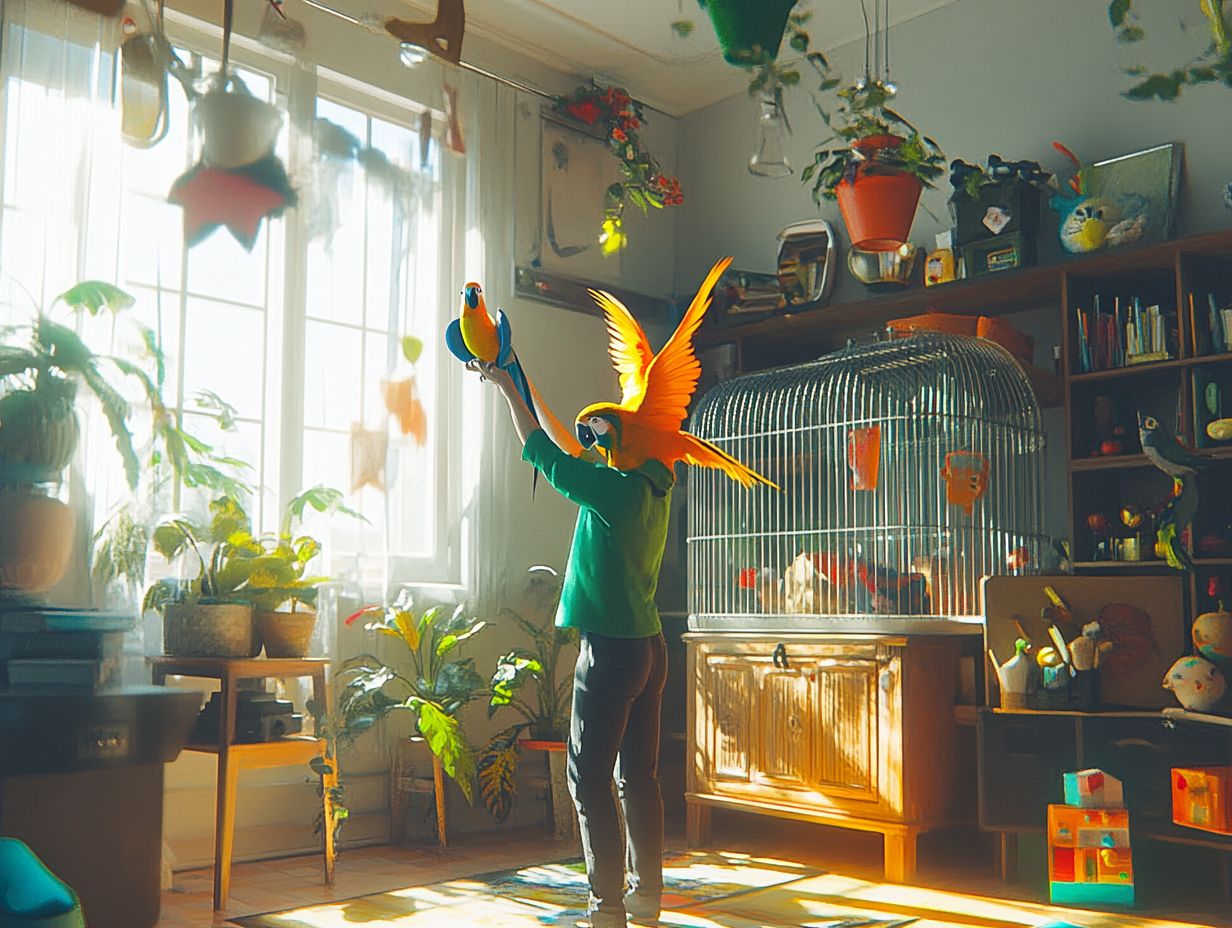
Establishing trust with your new parrot is crucial for nurturing a successful relationship. The initial steps toward this bond involve gentle interaction and the art of positive reinforcement.
Using treats can be particularly effective in creating a trusting environment. When you offer snacks that your parrot enjoys, you foster a sense of safety and appreciation. Engaging in fun activities like interactive play sessions with toys or allowing free flight within a controlled space not only enriches the parrot s surroundings but also encourages engagement.
As time passes, these positive experiences will significantly enhance your parrot’s comfort level, making it more likely to seek your companionship. By consistently using praise and rewards, you pave the way for improved behavior, reinforcing your parrot s confidence in you and deepening the connection between you both.
Socializing with Your Bird
Socializing with your bird is an essential part of parrot ownership. It nurtures companionship and strengthens the bond between you and your pet, paving the way for enriching interactions that benefit you both.
Building a Bond and Positive Interactions
Building a strong bond with your parrot involves creating positive interactions through consistent routines, playful training methods, and rewarding behaviors with treats.
Engaging in enjoyable activities, such as step-up training, fosters trust.
It also encourages your feathered friend to explore their surroundings with confidence.
Using a bird harness for outdoor walks opens the door to safe adventures, introducing new sights and sounds that pique their curiosity.
To enhance these experiences, keep your interactions playful. Incorporate whistles, songs, and gentle games that challenge your parrot mentally.
Rewarding their progress with favorite snacks instills a sense of achievement and reinforces positive behavior.
By varying your training techniques and ensuring every session is enjoyable, you can cultivate a deeper and lasting connection with your avian companion.
Dealing with Behavioral Issues
Navigating behavioral issues is an unavoidable aspect of parrot ownership. By comprehending the underlying causes of aggression or other undesirable behaviors, you can profoundly enhance both your experience and your bond with your feathered companion.
Common Problems and How to Address Them

Common challenges you might encounter with your parrot include aggression, excessive squawking, and a fear of new environments, each demanding your focused attention and understanding.
Recognizing these behavioral issues is your first step toward nurturing a harmonious relationship with your feathered companion.
Signs of aggression could present as biting or lunging, while an uptick in vocalizations often indicates boredom or anxiety. Fear of new settings may result in hiding or reluctance to engage, which can be unsettling for both you and your parrot.
Employing consistent and positive reinforcement training is a practical approach to modifying these behaviors effectively. Your role in this process is crucial; by maintaining a calm atmosphere during training sessions, you create a secure space for your parrot to gradually adjust to new experiences and learn appropriate responses.
A supportive environment is essential for fostering long-term behavioral improvement.
Encouraging Socialization with Other Birds
Encouraging socialization with other birds is essential to a parrot’s upbringing. This practice not only builds amazing social skills but also offers thrilling experiences that mirror their natural behaviors in a flock-like environment, highlighting the benefits of bird socialization.
By facilitating these interactions, you are setting the stage for a well-rounded, confident companion.
Tips for Introducing Your Bird to Other Birds
When you re introducing your parrot to other birds, following specific tips is crucial to foster positive interactions and minimize the chance of any aggressive behavior.
Begin with a gradual exposure plan; allow your parrot to observe the other birds from a safe distance before they meet face-to-face.
Pay close attention to the body language of both birds; signs like fluffed feathers or raised wings can signal discomfort or aggression, which may mean it s time to reassess the situation.
Utilizing a controlled environment is also wise consider dividing their spaces with a barrier to facilitate safe observations.
Most importantly, supervision during their interactions is essential; this enables you to intervene immediately if tensions escalate, ensuring the well-being of everyone involved.
Frequently Asked Questions
Address these issues swiftly to strengthen your bond!
Remember, nurturing your parrot’s development and addressing behavioral challenges is crucial for a fulfilling relationship with your feathered friend.
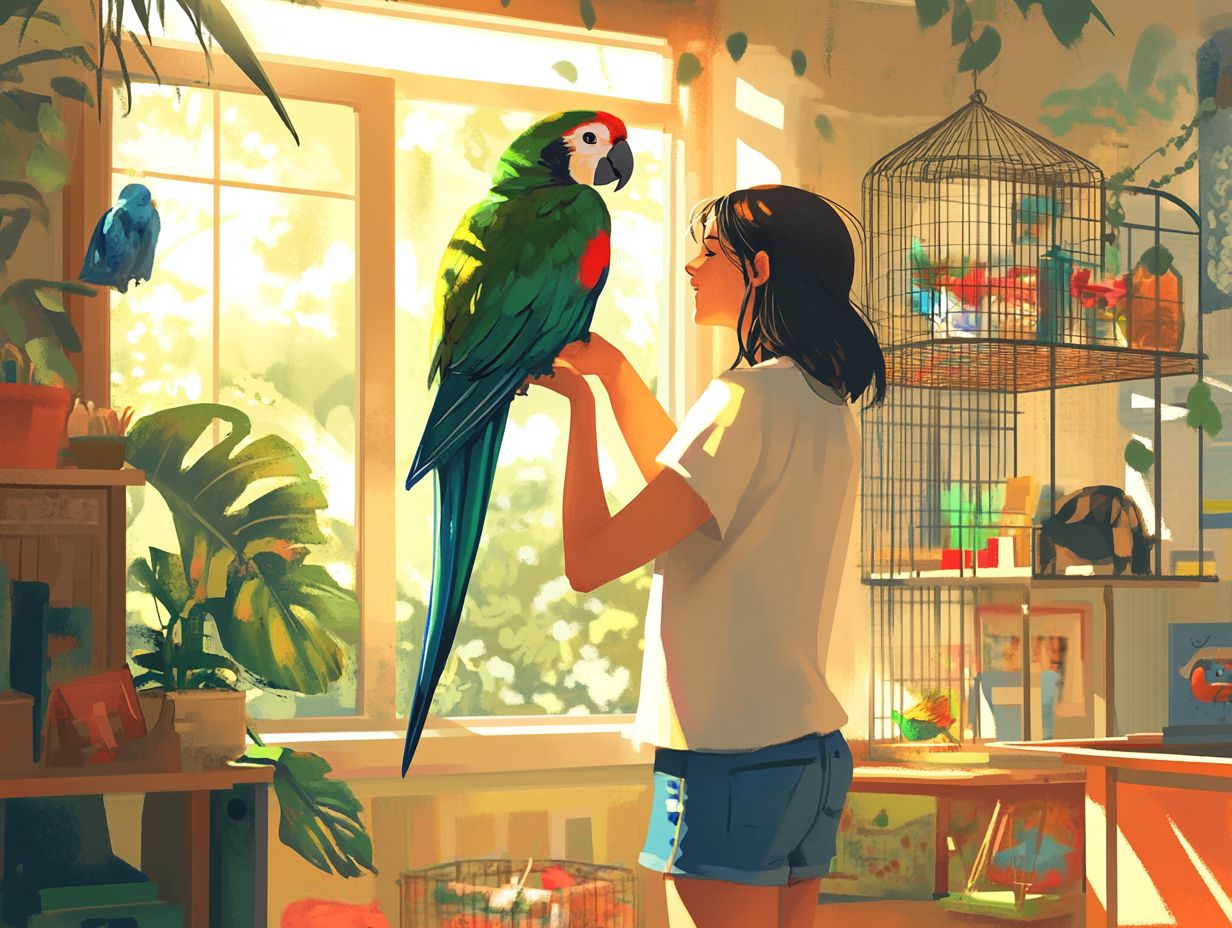
1. Give your bird time to adjust: It can be overwhelming for a bird to be in a new environment. Allow them to get comfortable with their surroundings before trying to understand the behavior of adopted birds and socialize.
2. Start with short interactions: Begin by talking to your bird and offering treats to help them become familiar with you without feeling overwhelmed.
3. Use rewards: Reward your bird with treats and praise when they show positive behaviors like approaching you. This encourages them to continue socializing and helps you understand the lifecycle of adopted birds.
How can I bond with my newly adopted bird?
1. Spend quality time together: Make sure to spend time together every day. This can include talking, playing with toys, or simply sitting near them.
2. Find their favorite treats: Every bird has favorite treats. Once you discover what they love, use those treats to bond during training or as a special reward.
3. Be patient: Building a bond takes time. Don t get discouraged if your bird takes longer to warm up to you.
Introduce your bird to other pets slowly. Always supervise their interactions to ensure safety. If your bird seems scared, keep them separated.
Yes, it s important for your bird to interact with others. This helps them become comfortable and social in different situations. Gradual introductions are key!
What if my bird, like Kili or Truman, is afraid of me?
If your bird is scared, give them space. Talk to them calmly near their cage, and move slowly to help them feel safe.
With time, your bird will become more comfortable and start to trust you. It s important to respect their boundaries and build a trusting relationship. Seeking help from a professional trainer may also be beneficial.
Start socializing your bird today, and watch your bond grow stronger!

